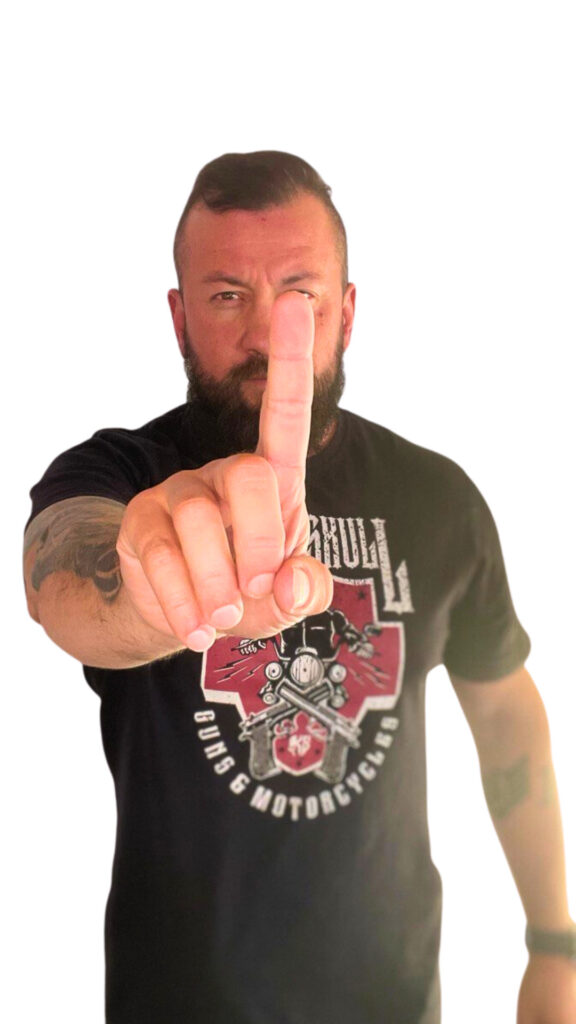There is a common practice in beginner shooting courses that involves determining the shooter’s dominant eye. The goal is to decide which eye the shooter should align their firearm with, influencing many shooting habits and training in the future. However, one frequently asked question is: I am right-handed, but my dominant eye is the left one, and now? – Relax, Young Padawan. Let’s explain!

The members of a bilateral pair of structures in the body seldom exhibit perfect equality. Often, one member of the pair tends to be preferred over the other in behavioral coordinations, or it seems to manifest physiological superiority. Thus, it is denned as dominant. If one consistently writes or throws a ball with the right hand, one is said to have a dominant right hand. Likewise, if one always kicks a ball with the left foot, this would be one’s dominant foot. Handedness and footedness are manifestations of sidedness or lateral dominance that have been described for centuries. They are so common that words derived from hand usage have been incorporated into the language. For example, the word adroit is derived from the French word referring to the right or agile side, while gawky refers to the left side. However, one does not encounter references to any form of lateral dominance other than that of the limbs until 1S93 when Porta discussed the existence of a dominant eye in his book De Refractione. Porta noticed that even when both eyes are open, the input from only one may be used. He suggested a demonstration that may easily be repeated: First, one holds a pencil directly in front of oneself. Then, keeping both eyes open, one aligns its tip with a point on a distant wall. If one alternately winks each eye, the pencil will remain in good alignment with the target for one eye’s view; however, for the other eye’s view, it will seem to be shifted out of alignment. This implies that the pencil and the distant point have been aligned only in one eye’s view, and the misaligned view of the other eye has been ignored or suppressed. It is intriguing to note that during the performance of this simple task, one is not aware that this alignment depends upon only a single eye’s view. Rather one believes that both eyes are simultaneously being used. (Porac, C., & Coren, S., 1976)

Understanding the initial concepts, let’s return to the initial question. From a shooting practice perspective, what is the implication of having cross-dominance between hands and eyes?
The phenomenon creates its greatest dilemma when you want to shoot with both eyes open. Let’s explore another concept:

“The horizontal horopter is the circle through the fixation point and the nodal points of the two eyes, usually referred to as the V–MC” (Müller, 1826 apud Turski, 2016).
Everything beyond or before the horopter causes double vision or diplopia. Considering three relevant points in space for shooting – rear sight, front sight, and the target, usually, when focusing on the front sight, you see two targets. If you see two targets, which one do you shoot at?
Furthermore, if my firearm is aligned with my left eye, and I have my right eye dominant, the image formed for me is the view of the side of the firearm instead of seeing the target through the sighting device. This explains a significant number of missed shots in combat.
Therefore, when learning to shoot with both eyes open, students often face some problems due to diplopia. Imagining the use of a long gun, the right-handed person supporting the gun on their right shoulder, keeping both eyes open tends to see the left side of the firearm instead of the sighting device and target. This brings us back to the question: I am right-handed, but my dominant eye is the left one, and now?
(1) When using pistols, there is little change from traditional training:
(a) The gun should be aligned in front of the dominant eye, so if you are right-handed and your dominant eye is the left one, it should be in front of the left eye.
(b) If you close one eye – which is generally not recommended – there is no diplopia.
(c) Training repetitions for motor conditioning (positioning the pistol in front of the eye) and cognitive (from the optic nerve to higher levels) are encouraged.
(2) When using long guns, there are some alternatives at the shooter’s discretion:
(a) Use alignment with the left eye, as if the shooter were entirely left-handed;
(b) Use highly illuminated sighting devices, such as good red dots or holographic sights, which generate the overlap of images, forming a univocal interpretation;
(c) Repetition training for motor (positioning the pistol in front of the eye) and cognitive (from the optic nerve to higher levels) conditioning is imperative for those with cross-dominance who intend to shoot with both eyes open: it is possible to teach your brain what you want it to interpret from the information received by the optic nerve.

Cross-dominance is not an obstacle for shooters. Understanding the physiological foundations of vision allows the adaptation of motor patterns and training that will generate excellent results. If you are one of those fortunate enough to have this characteristic, don’t worry. Treat your fundamentals responsibly, dedicate yourself to training, and, if you need help, of course, rely on ABA Intl’s training.
References
Porac, C., & Coren, S. (1976). The dominant eye. Psychological Bulletin, 83(5), 880–897. doi:10.1037/0033-2909.83.5.880
Annett, M. (1967). The Binomial Distribution of Right, Mixed and Left Handedness. Quarterly Journal of Experimental Psychology, 19(4), 327–333. doi:10.1080/14640746708400109
Turski, J. (2016). On binocular vision: The geometric horopter and Cyclopean eye. Vision research, 119, 73-81.
da Silveira, L. M. (2023). Introduction to combat shooting: Scientific foundations, training, and application for instructors and trainees. Editora CRV.
Kandel, E. R., Schwartz, J. H., Jessell, T. M., Siegelbaum, S., Hudspeth, A. J., & Mack, S. (Eds.). (2000). Principles of neural science New York: McGraw-hill.




